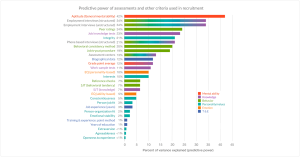For any talent acquisition process, it is significant to find the right fit for the company & culture. Considering the time and efforts impacting hiring and onboarding, why not take the help of predictive hiring?
Predictive hiring is recruiting software that uses data and analytics to help recruiters and hiring managers find the best applicants. Any usual, manual process requires resume screenings, interview rounds, and the interviewer’s consciousness to be in place. But with predictive analytics for hiring, historical data of candidates, machine learning tools, and statistical algorithms to support a decision.
The process of identifying, attracting, selecting, and retaining highly qualified personnel is known as talent acquisition. As a result, talent acquisition is an important aspect of the employee journey. As per the research, 96 percent of HR managers believe AI can greatly boost talent acquisition and retention.
The prediction helps in making data-driven decisions and this is the future of recruitment, so let’s understand how can you integrate predictive hiring with your organization’s talent acquisition strategy –
Candidate sourcing check
Recruiters, especially novice recruiters or recruiters for highly specialized professions, cannot be expected to grasp everything about the nuances of job requisition language. Here the AI comes into the picture. Not only does it understands the nuances of a job post and specialization but also has a search engine that focuses primarily on the intent and purpose of the applicant.
AI is capable of inferring the skills and interests of a particular candidate and matching them to the role requirements. This also gives a clear indication of the upskilling investment that helps in salary benchmarking with a candidate.
Screening and Interviews
Unlike sourcing, screening is data with varied information on the past and current employees’ resumes, competency, and skill models. These examples help a machine learning program to learn and understand the patterns in multiple candidates at the same time. It saves both recruiters and candidates a lot of time.
AI can pick up on fine points in online video interviews, such as gestures and facial expressions that humans may overlook. Similarly, because AI can analyze massive amounts of data without tiring, patterns that would otherwise go unnoticed by busy recruiters and hiring managers may emerge.

Reducing Bias
The AI is far better at treating all genders equally and dealing with large amounts of data.
Human recruiters have a finite amount of capacity, and as the volume of applications grows, the process begins to fail.
Although prejudice does occasionally enter into AI-assisted judgment, it is much easier to correct in an AI than it is in a human. A couple of hours of retraining with a data scientist is all it takes to “de-bias” the predictive hiring model. Mitigating bias with help of AI like PHAI helps with predictive talent acquisition in the best possible way.
Bringing Employee Benefits
With human biases, the retaining and hiring process has faced its share of challenges. Companies should strategize the talent acquisition process with the inclusion of predictive analytics. Employee Data is crucial in this analysis. The existing and procured data with employee surveys and feedback can be used with the predictive hiring process. Understanding how many employees are logging into benefits will be beneficial for the company data reports.
If there is data disparity in HR departments, employers should understand the “why” behind the requests of the workforce.
Deeper analytics will help in the personalization of employee benefits as it is no longer the equation of “one size fits all”. Once this is figured out, AI will enhance the process of hiring.
Finally
HR teams need to be self-educated, self-regulated while using comprehensive impact assessments that look at the entire applicant experience. They have to also monitor them by a collaborative team of legal and cybersecurity experts.
The innate power of AI is to discover patterns in massive amounts of data. The data-driven thinking that comes with integrating Ai in your processes can put human decision-making to the test. It is not a bad thing because it allows us to impede unconscious biases that we pass down as a result of our evolutionary rewiring.
Businesses need a strategy that revamps their operations and workforce management while recovering from the pandemic. Number-driven decisions are the way to go about predictive talent in the new age as the valuable insights promote diversity in the organization. And thus supercharging your talent acquisition strategy with predictive hiring will do wonders for your company.
For more such Updates Log on to www.hrtechcube.com












